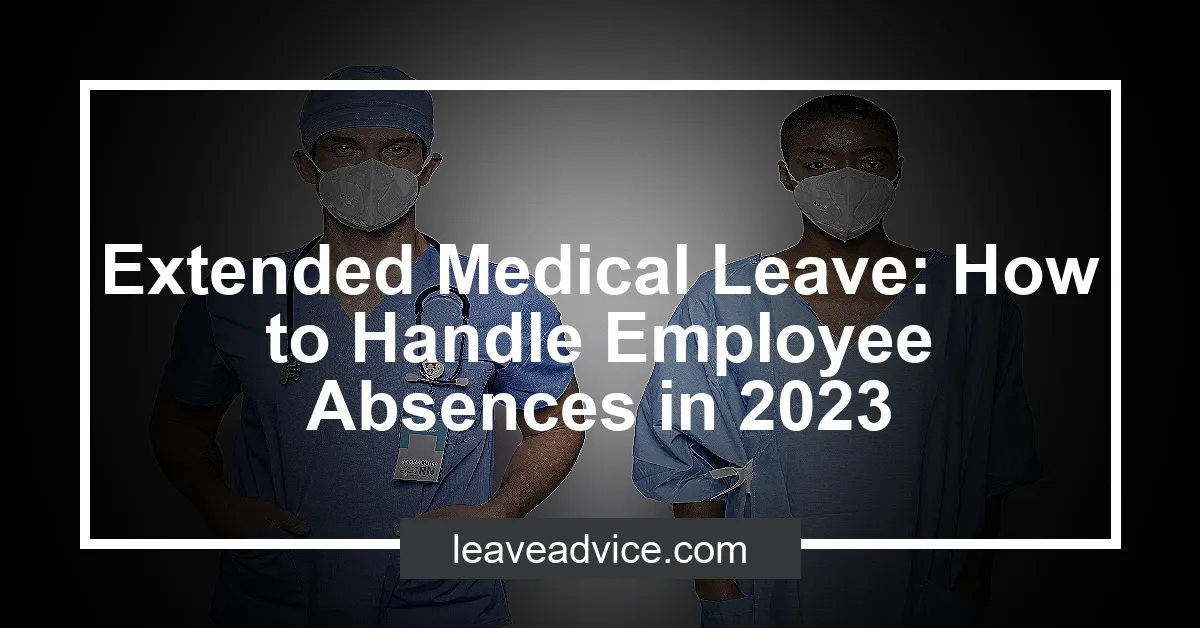Extended Medical Leave: How to Handle Employee Absences in 2023
Extended medical leave refers to a form of leave that lasts longer than 15 consecutive workdays, with or without pay. It is an important consideration for both employers and employees as it can have a significant impact on the workplace and the individual’s health and well-being.
Are you interested in employment problems and how they can affect workplaces? Check out this Youtube video all about the current state of extended medical leave in the Boston Police force, where 10% of the patrol force is currently on leave.
Applying for Extended Medical Leave
Extended medical leave refers to leave with or without pay that lasts for more than 15 consecutive workdays. Employees who are dealing with a serious health condition are qualified for extended medical leave, which is governed by the Family and Medical Leave Act (FMLA).
This article will tackle the basics of applying for extended medical leave.
Documentation Required
Applying for extended medical leave requires certain documentation to support the employee’s condition. Employers may require a certification from a medical professional to document the need for leave.
The employee’s health care provider must complete the medical certification, which states the employee’s health condition and when the condition began. Furthermore, the medical certification should also outline the nature of the medical condition, its duration, and its impact on the employee’s ability to perform their job.
Employers must provide the employee with at least 15 calendar days to provide the required documentation.
Length of Leave
Eligible employees may take up to 12 workweeks of unpaid extended medical leave within a 12-month period. The leave may be taken intermittently or on a reduced leave schedule if medically necessary.
Under certain circumstances, the leave may be extended beyond 12 workweeks. For example, military caregiver leave may be taken for up to 26 workweeks, while exigency leave for military families may be taken for up to 12 workweeks.
Employers must guarantee the employee’s job upon their return to work, and their job security should not be affected by the use of the extended medical leave.
Handling Employee Absences During Extended Medical Leave
Extended medical leave is a common occurrence in many workplaces. Employers must understand how to handle employee absences during this time, particularly regarding communication and temporary replacements.
Communication with Employee
Communication is crucial when an employee is absent due to extended medical leave. Employers must maintain regular communication with the employee to ensure they feel supported, and to keep them informed of any changes in the workplace.
Communication may include updates on projects, company news, or any other relevant information. It is also important to check in with the employee’s healthcare provider to stay informed of the employee’s progress.
Temporary Replacement
Employers should consider hiring a temporary replacement for an employee on extended medical leave, particularly if the role is crucial for the company’s operations. A temporary replacement can ensure that the workload is adequately managed and that projects continue to be delivered on time.
However, employers should assess the needs of the company and employee before making this decision. If the employee is able to work on a reduced schedule or from home, a temporary replacement may not be necessary.
Legal Considerations for Employers
ADA Compliance
Extended medical leave can be considered a reasonable accommodation under the Americans with Disabilities Act (ADA). ADA compliance must be considered by employers when handling extended medical leave requests.
Employers must receive an accommodation request from an employee and engage in the interactive process with the employee to determine if extended medical leave is a reasonable accommodation for their disability. Employers must also ensure that the leave does not pose an undue hardship on the business.
Employers must document all discussions and decisions made during the interactive process.
Worker’s Compensation
Worker’s compensation laws may provide wage replacement and medical benefits to employees with work-related injuries or illnesses. If an employee is on extended medical leave due to a work-related injury or illness, they may be eligible for worker’s compensation benefits.
Employers may have to work with the employee during the worker’s compensation claim process to ensure that the employee receives the benefits they are entitled to.
Worker’s compensation lawyers may assist employees who are having issues with their worker’s compensation claims or are experiencing retaliation from their employer for filing a worker’s compensation claim. Employers may also choose to have their own worker’s compensation lawyers to navigate the process and protect their business interests.
Conclusion
Extended medical leave can be a challenging experience for both employees and employers. Employers need to recognize the importance of supporting employees who require extended medical leave, as it can have a significant impact on their physical and mental health.
It is essential for employers to stay informed about laws and regulations governing medical leave and work with their employees to provide the necessary accommodations. Employers must also create supportive work environments and ensure open communication to promote a smooth transition back to work after extended medical leave.

